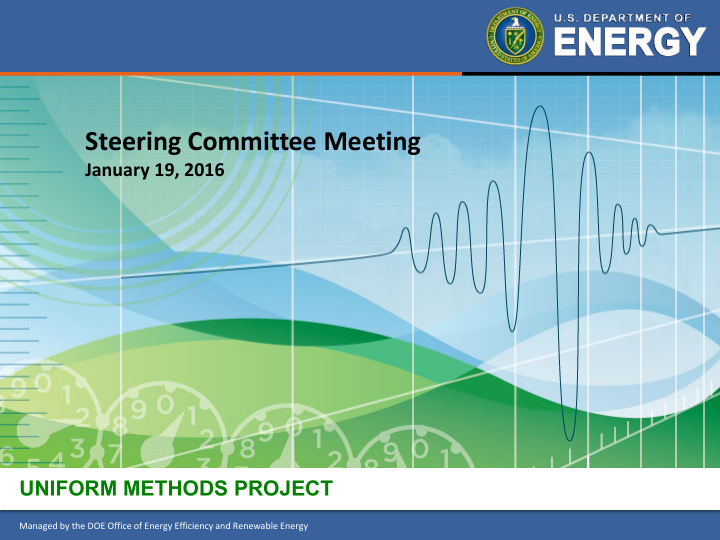



Steering Committee Meeting January 19, 2016 UNIFORM METHODS PROJECT 1 Uniform Methods Project Managed by the DOE Office of Energy Efficiency and Renewable Energy
Welcome Welcome to the Uniform EM&V Methods Project Steering Committee Meeting January 19, 2016 • Step 1: Enter your unique Audio Pin after you log in to this presentation. This Audio Pin will be located below your Audio Access Code. Be sure phone is not muted when entering Audio PIN. • Step 2: If you are listening to the webinar via telephone, please be sure that you select Telephone under the Audio pane. Please keep your phone muted unless you are speaking. • Note: If you are experiencing any technical issues, please send us a note via the Questions pane on the GoToMeeting dashboard. • If you have a questions, feel free to “raise your hand” or use the “Questions” feature at any time. 2 Uniform Methods Project 2
Agenda • Introduction • Combined Heat and Power Protocol Overview – George Simons, Itron • Strategic Energy Management Protocol Overview – Jim Stewart, Cadmus • Updates to past protocols – Cadmus • Closing / Next steps 3 Uniform Methods Project
Combined Heat and Power (CHP) Protocol Measure Description • CHP systems provide both electricity and thermal energy: primarily for onsite use – Involve capture and use of waste heat • Combined Heat and Power (CHP) systems include: – IC Engines – Gas Turbines – Microturbines – Fuel Cells – Boiler/Steam Turbines • Fuels: – Natural gas – Biogas – Oil – Woody biomass 4 Uniform Methods Project
CHP Protocol, cont. Protocol Approach • Comprehensive method for estimating impacts – Estimating CHP electricity and fuel impacts Metered data as well as algorithms for assessing impacts – Provides for CHP performance metrics – Offers default values where data is not available • Components of M&E plan – Use of on-site inspection data What on-site data is needed – CHP performance data from metering Meter requirements and frequency of data – Dealing with multiple fuels Natural gas, biogas, directed biogas – Interactive effects Estimating impacts across boilers, generators, chillers 5 Uniform Methods Project
CHP Protocol, cont. Challenges • Early retirement and degradation – Changes in fuel and electricity prices can result in unexpected retirement – Without ongoing maintenance programs, aging can reduce CHP performance • Normalizing CHP performance – CHP operations are not weather dependent and cannot be easily weather normalized – CHP performance can vary significantly due to changes in fuel and electricity prices; changes in process loads; CHP system maintenance, etc. – Requires annual estimates and long term metering • Net to gross estimation – CHP systems are complex and require significant effort – Free ridership and spillover do not occur as frequently as for other EE measures – Recommend that evaluators use best practices and close coordination between teams collecting site data and estimating impacts 6 Uniform Methods Project
Strategic Energy Management (SEM) Protocol Measure description Strategic Energy Management is a set of energy use principles and practices emphasizing continuous improvements in energy management and energy efficiency in industrial facilities or large commercial buildings – Achieves improvements through systematic and planned changes in facility operations, maintenance, and behaviors – Typical steps: (1) Establish management support, set goals, and engage employees; (2) Identify opportunities and implement; (3) Track progress; and (4) Update goals and plans. – Leads to sustained increases in energy efficiency 7 Uniform Methods Project
SEM Protocol, cont. Protocol Approach – Measure Definition – Application Conditions of Protocol • Relationship to Existing Evaluation Protocols – Savings Estimation • Facility as analysis unit • Collection of facility energy use, output, occupancy, and weather • Regression analysis • Option C of IPMVP – M&V Methods • Statistical Analysis • Onsite Verification • Non-routine Adjustments – Other Evaluation Issues • Sampling – Resources/References 8 8 Uniform Methods Project
SEM Protocol, cont. Challenges • Ability to detect expected savings • Recommend conducting statistical power analysis • Data availability • Recommend collecting baseline and engagement period data for relevant variables • Robustness of regression savings estimates • Tests to check robustness of savings estimates • Omitted variables • Changes in production or input characteristics unrelated to SEM that are difficult to model statistically • Apply non-routine adjustments – use sparingly • Non-routine adjustments should be based on engineering analysis with all assumptions and calculations clearly documented • Evaluation of SEM program facility savings seeking SEP certification • Harmonize evaluation approaches to extent feasible 9 Uniform Methods Project
Past Protocol Updates • Collection of feedback from authors of past protocols • Proposed approach for publishing updates to past protocols: TAG Cadmus Publish Author NREL Protocol Status Review Technical 2016 review copyedit (incl. SC) Review version No updates X X Minor updates X X X X Substantive X X X X X updates 10 Uniform Methods Project
Schedule and Next Steps Steering committee review – CHP, Review by February 2 nd – SEM, February 2016 – Send feedback to Erina.Keefe@cadmusgroup.com and Chuck.Kurnik@nrel.gov General Schedule – Mid-February and March 2016 – Stakeholder review – May and June 2016 – Final reviews and formatting – July and August 2016 – Publication 11 Uniform Methods Project
Discussion Questions? – UMP management team: • Erina.Keefe@cadmusgroup.com • Arlis.Reynolds@cadmusgroup.com • Chuck.Kurnik@nrel.gov • Michael.Li@EE.doe.gov – CHP protocol author: George.Simons@itron.com – SEM protocol author: Jim.Stewart@cadmusgroup.com UMP protocols – Final: http://energy.gov/eere/about-us/ump-protocols – Draft: http://www.nrel.gov/extranet/ump/draft_protocols.html Thank you! 12 Uniform Methods Project
Recommend
More recommend